
Nabil Kanso was an American painter. Kanso began his career in 1968, New York during the start of the neo-expressionist movement. His works dealt with contemporary, historical and literary themes, and were marked by figurative imagery executed with spontaneous and vigorous handling of the paint and often done on large-scale formats. They reflected movement and tension embodying intense colors and symbolic forms addressing social, political, and war issues. The Vietnam War and the Lebanese Civil War profoundly affected the development and scope of his themes dealing with violence and war. His long-running Split of Life series encompassed an extensive range of enormous paintings depicting scenes of human brutality and suffering.

The Split of Life is a series of over 80 mural size oil paintings by Nabil Kanso. The paintings span a period from 1974 to 1994, and deal with contemporary and historical issues of war and violence.

Faust is a series of approximately 100 paintings created between 1976 and 1979 by Nabil Kanso. The paintings depict figural compositions in a sequence of scenes whose subjects are loosely based on Goethe's 1808 play Faust Part One and Part Two.

Othello is a series of paintings executed in 1985 by Nabil Kanso. The subjects of the paintings are loosely based on Shakespeare’s tragedy Othello. The series comprises 60 paintings dealing with themes of love, race, jealousy, betrayal, and evil. They depict scenes embodying compositions of figural and metaphorical imagery that may be seen as visually reflecting the intimate and dramatic relationship between Othello and Desdemona, and the tense and uneasy relation that passes between and through Othello, Desdemona and Iago.
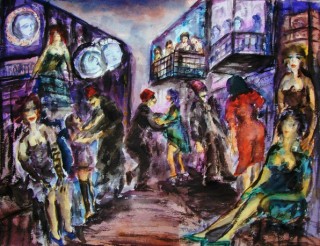
Place des Martyres is the title of a series of over 250 watercolors and drawings executed in New York and Beirut between 1971 and 1974 by Nabil Kanso. The subjects of the works in the series are based on the women headquartered in the red-light district of Beirut city center called el Bourj, and after World War I named Place des Martyrs in memory of dozens of Arab nationalists who were hanged in 1915-16 during Ottoman rule.

America 500 Years is the title of a series of paintings created in 1988–1991 by Nabil Kanso in commemoration of the 500th anniversary of the discovery of America. The works in the series base their subjects on historical events in the Americas over the course of five centuries.
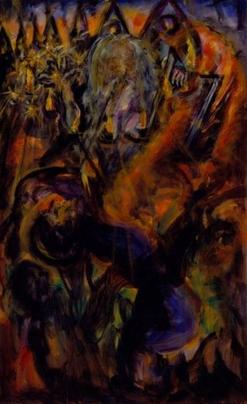
The Apocalypse Series encompasses 125 works consisting of 75 paintings and 50 drawings created between 1982 and 1984 by Nabil Kanso. The subjects of the works in the series are based on the Revelation of Saint John the Evangelist. The colors of this painting are somber, suggesting richness and heaviness, while the repetitive geometry of the shapes suggest apocalyptic inevitability. In Peran Erminy's article, The Apocalyptic Paintings of Nabil Kanso, he clearly states that Kanso's paintings portray our world today. He states that our world is constantly surrounded by violence and people feel vulnerable. The aggression one has can ultimately lead to a break out in war where the world will be doomed. Kanso's paintings reflect the path we are taking as a world. People today are quick to act upon threats leading us into a world that is ruled by war. This will be the hell on earth made by none other than human beings themselves. Kanso has a strong, intense effect on his audience's feelings and emotions. Kanso's work is dark and sometimes frightening, conveying how it is relevant to the scary obstacles of today's world. Our society seems to be stuck on depressing violence and aggression and if continued on this path, will only continue to result in tragic wars.

Vietnam is a mural-size painting made by Nabil Kanso in 1974 in response to the Vietnam War. It is done in oil on canvas measuring 3.65 by 7.30 meters.

Hiroshima Nagasaki One-Minute is the subject of two mural-scale paintings made by Nabil Kanso in 1978–79. One is titled 49-Second (Hiroshima) done in oil on canvas measuring 3 X 5.50 meters, the other 11-Seconds (Nagasaki) oil-on-canvas triptych measuring 3 X 4.60 meters center, and 2.75 X 1.32 meters each side.

Living Memory is the title of a series of 9 mural-size paintings on the Holocaust painted by Nabil Kanso in 1980, 1990 and 1993–94.

Time Suspended in Space is the title of a mural-size painting on apartheid in South Africa painted by Nabil Kanso in 1980. It is oil on canvas measuring 3.65 X 5.50 meters.
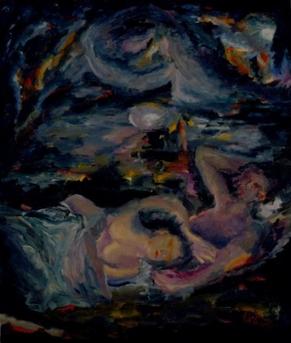
Dreamvision (paintings) is a series of 28 oil paintings made by Nabil Kanso in 1980–81. The subjects of the works in the series are two figures of a man and woman whose characters and relations are reinforced by figurative allusions to their surroundings.
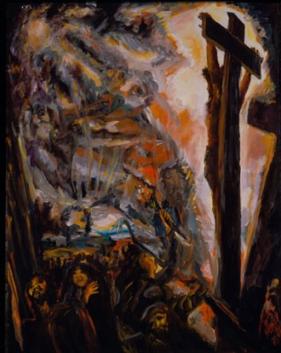
The Crucifixion is the subject of a painting by Nabil Kanso painted in 1983.
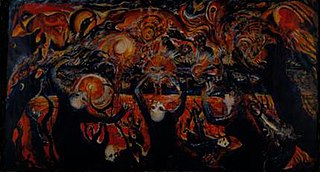
Lebanon Summer 1982 is the title and subject of a mural-scale painting made by Nabil Kanso in 1982 on the Sabra and Shatila massacre during the Lebanese Civil War. It is oil on canvas measuring 3 X 5.5 meters

The Vortices of Wrath is a triptych painted by Nabil Kanso in 1977. It is part of the Lebanon series began in 1975 in response to the Lebanese Civil War. The triptych is done in oil on canvas measuring 3×7.60 meters. The center is 3×3 meters and each side 2.75×2.30 meters.
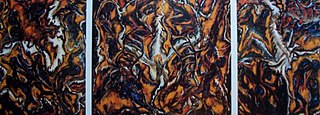
The Floating Shadows is a triptych made by Nabil Kanso in 1986 on the brutality and suffering inflicted during the Lebanese Civil War. The painting is oil on canvas and measures 2.75 x 7.60 meters. It forms part of the Cluster Paintings series that Kanso began in 1986 and marks the transition to a new approach in his compositional framework. The pictorial layout divides the canvas space into various sections reflecting a cluster of interlinked planes depicting floating figures of predominantly dark-blue set against deep orange ground and demarcated by white grayish areas.

Cluster Paintings are a series of paintings created by Nabil Kanso in 1986–1988. They are characterized by compositions that divide the canvas space into sections reflecting a cluster of irregular shaped planes offering variations of contrasts and viewpoints. These characteristics expanded in later works such as the America and Living Memories series.
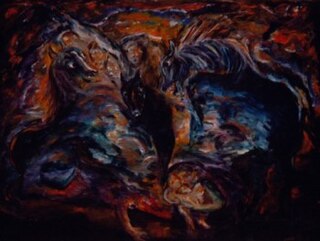
Apocalyptic Rider is a painting created by Nabil Kanso in 1980. It is oil on canvas measuring 7 X 9 feet, and is part of a series depicting horsemen in compositions dealing with apocalyptic themes.
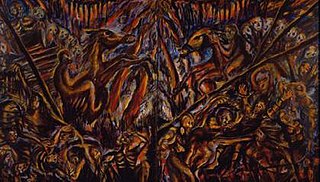
Apocalyptic Riders is a diptych executed in 1984 and is part of a series begun in 1980 by Nabil Kanso.

Endless Night is a painting executed in 1983 by Nabil Kanso in oil paint on canvas measuring 2.25 by 3 metres. It is part of a group of related paintings made by Kanso in response to the Lebanese Civil War. The painting depicts the ravages war in a scene that "embodies recurrent themes of carnage, suffering and the disintegration of humanity."




















